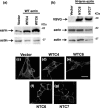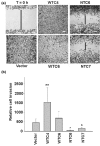The membrane cytoskeletal crosslinker ezrin is required for metastasis of breast carcinoma cells
- PMID: 15987432
- PMCID: PMC1143558
- DOI: 10.1186/bcr1006
The membrane cytoskeletal crosslinker ezrin is required for metastasis of breast carcinoma cells
Abstract
Introduction: The membrane cytoskeletal crosslinker ezrin participates in several functions including cell adhesion, motility and cell survival, and there is increasing evidence that it regulates tumour progression. However, the role played by ezrin in breast cancer metastasis has not been clearly delineated.
Methods: We examined the role of ezrin in metastasis using a highly metastatic murine mammary carcinoma cell line, namely AC2M2. Stable cell clones that overexpress wild-type ezrin or a dominant-negative amino-terminal domain of ezrin were selected. They were then tested for cell motility and invasion in vitro, and metastasis in a mouse in vivo tumour transplantation model.
Results: Parental AC2M2 cells and cells overexpressing wild-type ezrin were transplanted into the mammary fat pad of syngeneic recipient mice; these animals subsequently developed lung metastases. In contrast, expression of the dominant-negative amino-terminal ezrin domain markedly inhibited lung metastasis. Consistent with this effect, we observed that the expression of amino-terminal ezrin caused strong membrane localization of cadherin, with increased cell-cell contact and a decrease in cell motility and invasion, whereas cells expressing wild-type ezrin exhibited strong cytoplasmic expression of cadherins and pseudopodia extensions. In addition, inhibitors of phosphatidylinositol 3-kinase and c-Src significantly blocked cell motility and invasion of AC2M2 cells expressing wild-type ezrin. We further found that overexpression of amino-terminal ezrin reduced levels of Akt pS473 and cytoskeletal-associated c-Src pY418 in AC2M2 cells, which contrasts with the high levels of phosphorylation of these proteins in cells expressing wild-type ezrin. Phosphorylated Erk1/2 was also reduced in amino-terminal ezrin expressing cells, although a mitogen-activated protein kinase kinase (MEK) inhibitor had no detectable effect on cell motility or invasion in this system.
Conclusion: Our findings indicate that ezrin is required for breast cancer metastasis, and that c-Src and phosphatidylinositol 3-kinase/Akt are effectors of ezrin in the cell motility and invasion stages of the metastatic process. Together, these results suggest that blocking ezrin function may represent a novel and effective strategy for preventing breast cancer metastasis.
Figures




References
Publication types
MeSH terms
Substances
LinkOut - more resources
Full Text Sources
Other Literature Sources
Medical
Molecular Biology Databases
Research Materials
Miscellaneous

